Modelling the Effects of Weather Conditions on Cereal Grain Contamination with Deoxynivalenol in the Baltic Sea Region
Abstract
1. Introduction
2. Results
2.1. Association between DON Contamination Level and Weather Conditions
2.1.1. Sweden
2.1.2. Lithuania
2.1.3. Poland
2.2. Development of a Prediction Model to Classify the Risk of DON Contamination
2.2.1. Sweden
2.2.2. Lithuania
2.2.3. Poland
3. Discussion
4. Materials and Methods
4.1. Association between the Level of DON Contamination in Grain and the Weather Condition
4.1.1. Field Data
4.1.2. DON Analysis
4.1.3. Weather and Environmental Data
4.1.4. Phenology
4.1.5. Data Analysis
4.2. Prediction Model to Classify the Risk of DON Contamination in Grain
4.2.1. Development of a Prediction Model to Classify the Risk of DON Contamination in Grain
4.2.2. Model Testing and Comparison
4.2.3. Identification of the Most Important Variables
4.3. Software
Author Contributions
Funding
Institutional Review Board Statement
Informed Consent Statement
Data Availability Statement
Acknowledgments
Conflicts of Interest
References
- Moretti, A.; Pascale, M.; Logrieco, A.F. Mycotoxin risks under a climate change scenario in Europe. Trends Food Sci. Technol. 2019, 84, 38–40. [Google Scholar] [CrossRef]
- Perrone, G.; Ferrara, M.; Medina, A.; Pascale, M.; Magan, N. Toxigenic fungi and mycotoxins in a climate change scenario: Ecology, genomics, distribution, prediction and prevention of the risk. Microorganisms 2020, 8, 1496. [Google Scholar] [CrossRef]
- Bottalico, A.; Perrone, G. Toxigeneic Fusarium species and mycotoxins associated with head blight in small-grain cereals in Europe. Eur. J. Plant Pathol. 2002, 108, 611–624. [Google Scholar] [CrossRef]
- Moss, M.O.; Thrane, H. Fusarium taxonomy with relation to trichothecene formation. Toxicol. Lett. 2004, 153, 23–28. [Google Scholar] [CrossRef]
- Kosiak, B.; Torp, M.; Skjerve, E.; Thrane, U. The prevalence and distribution of Fusarium species in Norwegian cereals: A survey. Acta Agric. Scand. Sect. B Soil Plant Sci. 2007, 53, 168–176. [Google Scholar] [CrossRef]
- European Union. Commission Regulation (EC) No 1881/2006 of 19 December 2006 Setting Maximum Levels for Certain Contaminants in Foodstuffs (Text with EEA Relevance). 2020. Available online: https://eur-lex.europa.eu/legal-content/EN/TXT/?uri=CELEX%3A02006R1881-20201014 (accessed on 6 June 2021).
- Xu, X.-M.; Nicholson, P.; Thomsett, M.A.; Simpson, D.; Cooke, B.M.; Doohan, F.M.; Brennan, J.; Monaghan, S.; Moretti, A.; Mule, G.; et al. Relationship between the fungal complex causing Fusarium Head Blight of wheat and environmental conditions. Phytopathology 2008, 98, 69–78. [Google Scholar] [CrossRef]
- Hofgaard, I.S.; Aamodt, H.U.; Torp, T.; Jestoi, M.; Lattanzio, V.M.T.; Klemsdal, S.S.; Waalwijk, C.; Van der Lee, T.; Brodal, G. Association between Fusarium species and mycotoxins in oats and spring wheat from farmers´ fields in Norway over a six-year period. World Mycotoxin J. 2016, 9, 365–378. [Google Scholar] [CrossRef]
- Vogelgsang, S.; Beyer, M.; Pasquali, M.; Jenny, E.; Musa, T.; Bucheli, T.D.; Wettstein, F.E.; Forrer, H.R. An eight-year survey of wheat shows distinctive effects of cropping factors on different Fusarium species and associated mycotoxins. Eur. J. Agron. 2019, 105, 62–77. [Google Scholar] [CrossRef]
- Kochiieru, Y.; Mankevičienė, A.; Cesevičienė, J.; Semaškienė, R.; Dabkevičius, Z.; Janavičienė, S. The influence of harvesting time and meteorological conditions on the occurrence of Fusarium species and mycotoxin contamination of spring cereals. J. Sci. Food Agric. 2020, 100, 2999–3006. [Google Scholar] [CrossRef] [PubMed]
- Mankevičienė, A.; Butkutė, B.; Dabkevičius, Z.; Supronienė, S. Fusarium mycotoxins in Lithuanian cereals from the 2004–2005 harvests. Ann. Agric. Environ. Med. 2007, 14, 103–107. [Google Scholar] [PubMed]
- Mankevičienė, A.; Butkutė, B.; Gaurilčikienė, I.; Dabkevičius, Z.; Supronienė, S. Risk assessment of Fusarium mycotoxins in Lithuanian small cereal grains. Food Control 2011, 22, 970–976. [Google Scholar] [CrossRef]
- Mankevičienė, A.; Jablonskytė-Raščė, D.; Maikštėnienė, S. Occurrence of mycotoxins in spelt and common wheat grain and their products. Food Addit. Contam. Part A 2014, 31, 132–138. [Google Scholar] [CrossRef]
- Stępień, Ł.; Popiel, D.; Koczyk, G.; Chełkowski, J. Wheat-infecting Fusarium species in Poland—Their chemotypes and frequencies revealed by PCR assay. J. Appl. Genet. 2008, 49, 433–441. [Google Scholar] [CrossRef] [PubMed]
- Lindblad, M.; Gidlund, A.; Sulyok, M.; Börjesson, T.; Krska, R.; Olsen, M.; Fredlund, E. Deoxynivalenol and other selected Fusarium toxins in Swedish wheat—Occurrence and correlation to specific Fusarium species. Int. J. Food Microbiol. 2013, 167, 284–291. [Google Scholar] [CrossRef]
- Wolny-Koladka, K.; Lenart-Boroń, A.; Boroń, P. Species composition and molecular assessment of the toxigenic potential in the population of Fusarium spp. isolated from ears of winter wheat in southern Poland. J. Appl. Bot. Food Qual. 2015, 144, 139–144. [Google Scholar] [CrossRef]
- Hietaniemi, V.; Rämö, S.; Yli-Mattila, T.; Jestoi, M.; Peltonen, S.; Kartio, M.; Sieveläinen, E.; Koivisto, T.; Parikka, P. Updated survey of Fusarium species and toxins in Finnish cereal grains. Food Add. Contam. Part A. 2016, 33, 831–848. [Google Scholar] [CrossRef] [PubMed]
- Kuzdraliński, A.; Nowak, M.; Szczerba, H.; Dudziak, K.; Muszyńska, M.; Leśniowska-Nowak, J. The composition of Fusarium species in wheat husks and grains in south-eastern Poland. J Integr. Agric. 2017, 16, 1530–1536. [Google Scholar] [CrossRef]
- Parikka, P.; Hakala, K.; Tiilikkala, K. Expected shifts in Fusarium species’ composition on cereal grain in Northern Europe due to climatic change. Food Addit. Contam. Part A 2012, 29, 1543–1555. [Google Scholar] [CrossRef]
- Yli-Mattila, T.; Paavanen-Huhtala, S.; Parikka, P.; Hietaniemi, V.; Jestoi, M.; Gagkaeva, T.; Sarlin, T.; Haikara, A.; Laaksonen, S.; Rizzo, A. Real-time PCR detection and quantification of Fusarium poae, F. graminearum, F. sporotrichioides and F. langsethiaea compared to mycotoxin production in grains in Finland and Russia. Arch Phytopathol. Plant Prot. 2008, 41, 243–260. [Google Scholar] [CrossRef]
- Nielsen, L.K.; Jensen, J.D.; Nielsen, G.C.; Jensen, J.E.; Spliid, N.H.; Thomsen, I.K.; Justesen, A.F.; Collinge, D.B.; Jørgensen, L.N. Fusarium head blight of cereals in Denmark: Species complex and related mycotoxins. Phytopathology 2011, 101, 960–969. [Google Scholar] [CrossRef] [PubMed]
- Edwards, S.G.; Imathiu, S.M.; Ray, R.V.; Back, M.; Hare, M.C. Molecular studies to identify the Fusarium species responsible for HT-2 and T-2 mycotoxins in UK oat. Int. J. Food Microbiol. 2012, 156, 168–175. [Google Scholar] [CrossRef]
- Fredlund, E.; Gidlund, A.; Sulyok, M.; Börjesson, T.; Krska, R.; Olsen, M.; Lindblad, M. Deoxynivalenol and other selected Fusarium toxins in Swedish oats—Occurrence and correlation to specific Fusarium species. Int. J. Food Microbiol. 2013, 167, 267–283. [Google Scholar] [CrossRef]
- Karlsson, I.; Friberg, H.; Kolseth, A.K.; Steinberg, C.; Persson, P. Agricultural Factors Affecting Fusarium Communities in Wheat Kernels. Int. J. Food Microbiol. 2017, 252, 53–60. [Google Scholar] [CrossRef]
- Bilska, K.; Jurczak, S.; Kulik, T.; Ropelewska, E.; Olszewski, J.; Żelechowski, M.; Zapotoczny, P. Species composition and trichothecene genotype profiling of Fusarium field isolates recovered from wheat in Poland. Toxins 2018, 10, 325. [Google Scholar] [CrossRef]
- Persson, T.; Eckersten, H.; Elen, O.; Roer-Hjelkrem, A.G.; Markgren, J.; Söderström, M.; Börjesson, T. Predicting deoxynivalenol in oats under conditions representing Scandinavian production regions. Food Addit. Contam. Part A 2017, 34, 1026–1038. [Google Scholar] [CrossRef] [PubMed]
- Fredlund, E.; Gidlund, A.; Pettersson, H.; Olsen, M.; Börjesson, T. Real-Time PCR Detection of Fusarium Species in Swedish Oats and Correlation to T-2 and HT-2 Toxin Content. World Mycotoxin J. 2010, 3, 77–88. [Google Scholar] [CrossRef]
- Hartmann, E. Slutrapport Beträffande Foder & Spannmåls Projekt om Förekomst av DON i 2020 års Spannmålsskörd i Sverige. Available online: https://www.foderochspannmal.se/material-om-mykotoxiner-51.aspx (accessed on 6 June 2021). (In Swedish).
- Suproniene, S.; Justesen, A.F.; Nicolaisen, M.; Mankeviciene, A.; Dabkevicius, Z.; Semaskiene, R.; Leistrumaite, A. Distribution of trichothecene and zearalenone producing Fusarium species in grain of different cereal species and cultivars grown under organic farming conditions in Lithuania. Ann. Agric. Environ. Med. 2010, 17, 79–86. [Google Scholar]
- Suproniene, S.; Sakalauskas, S.; Mankevičienė, A.; Barčauskaitė, K.; Jonavičienė, A. Distribution of B type trichothecene producing Fusarium species in wheat grain and relation to mycotoxins DON and NIV concentrations. Zemdirbyste 2016, 103, 281–288. [Google Scholar] [CrossRef][Green Version]
- Sakalauskas, S.; Stumbrienė, K.; Supronienė, S.; Švėgžda, P. Changes in Fusarium Link species composition from Lithuanian wheat grain in years 2005–2007 to 2011–2013. Proc. Latvia Univ. Agric. 2014, 32, 45–50. [Google Scholar] [CrossRef]
- Janavičienė, A.; Supronienė, S.; Semaškienė, R. Microdochium nivale and M. majus as causative agents of seedling blight in spring cereals. Zemdirb. Agric. 2016, 103, 363–368. [Google Scholar] [CrossRef]
- Kochiieru, Y.; Mankevičienė, A.; Cesevičienė, J.; Semaškienė, R.; Ramanauskienė, J.; Gorash, A.; Janavičienė, S.; Venslovas, E. The Impact of Harvesting Time on Fusarium Mycotoxins in Spring Wheat Grain and Their Interaction with Grain Quality. Agronomy 2021, 11, 642. [Google Scholar] [CrossRef]
- Stepień, Ł.; Chełkowski, J. Fusarium head blight of wheat: Pathogenic species and their mycotoxins. World Mycotoxin J. 2010, 3, 107–119. [Google Scholar] [CrossRef]
- Wiśniewska, H.; Stępień, Ł.; Waśkiewicz, A.; Beszterda, M.; Góral, T.; Belter, J. Toxigenic Fusarium species infecting wheat heads in Poland. Centr. Eur. J. Biol. 2014, 9, 163–172. [Google Scholar] [CrossRef]
- Chełkowski, J.; Gromadzka, K.; Stępień, Ł.; Lenc, L.; Kostecki, M.; Berthiller, F. Fusarium species, zearalenone and deoxynivalenol content in preharvest scabby wheat heads from Poland. World Mycotoxin J. 2012, 5, 133–141. [Google Scholar] [CrossRef]
- Góral, T.; Ochodzki, P.; Nielsen, L.K.; Walentyn-Góral, D. Species of the genus Fusarium and Fusarium toxins in the grain of winter and spring wheat in Poland in 2009 and 2010. Biuletyn IHAR 2021, in press. [Google Scholar]
- Platforma Sygnalizacji Agrofagów; Góral, T.; Ochodzki, P.; Grelewska-Nowotko, K.; Grzeszczak, I. Skład Gatunkowy Grzybów z Rodzaju Fusarium Powodujących Fuzariozę Kłosów Pszenicy oraz Skażenie Ziarna Toksynami Fuzaryjnymi w Latach 2014–2015; Góral, T.; Ochodzki, P.; Żurawska-Zajfert, M.; Skład Gatunkowy Grzybów z Rodzaju Fusarium Powodujących Fuzariozę Kłosów Pszenicy Oraz Skażenie Ziarna Toksynami Fuzaryjnymi w Roku 2016; Góral, T.; Ochodzki, P.; Grelewska-Nowotko, K.; Żurawska-Zajfert, M. Skład Gatunkowy Grzybów z Rodzaju Fusarium Powodujących Fuzariozę Kłosów Pszenicy Oraz Skażenie Ziarna Toksynami Fuzaryjnymi w Roku 2017; Góral, T.; Ochodzki, P.; Grelewska-Nowotko, K. Skład Gatunkowy Grzybów z Rodzaju Fusarium Powodujących Fuzariozę Kłosów Pszenicy Oraz Skażenie Ziarna Toksynami Fuzaryjnymi w Roku 2019. Available online: https://www.agrofagi.com.pl/121,choroby (accessed on 6 June 2021). (In Polish).
- EFSA (European Food Safety Authority); Maggiore, A.; Afonso, A.; Barrucci, F.; De Sanctis, G. Climate change as a driver of emerging risks for food and feed safety, plant, animal health and nutritional quality. EFSA Supporting Publ. 2020, 17, 1881E. [Google Scholar]
- FAO. Climate Change: Unpacking the Burden on Food Safety; FAO—Food and Agriculture Organization of the United Nations: Rome, Italy, 2020. [Google Scholar]
- Van der Fels-Klerx, H.J.; Goedhart, P.W.; Elen, O.; Börjesson, T.; Hietaniemi, V.; Booij, C.J.H. Modeling deoxynivalenol contamination of wheat in northwestern Europe for climate change assessments. J. Food Prot. 2012, 75, 1099–1106. [Google Scholar] [CrossRef]
- Van der Fels-Klerx, H.J.; Olesen, J.E.; Madsen, M.S.; Goedhart, P.W. Climate change increases deoxynivalenol contamination of wheat in North-Western Europe. Food Addit. Contam. Part A 2012, 29, 1593–1604. [Google Scholar] [CrossRef] [PubMed]
- Janavičienė, S. Changes in Type A and B Trichothecenes, Important Grain Quality Factors, during Cultivation of Spring Cereals and Grain Storage. Doctoral Dissertation, Vytautas Magnus University, Kaunas, Lithuania, 2019. Available online: https://www.lammc.lt/data/public/uploads/2019/11/sigita-janaviciene_disertacija_spausdinimui_b5.pdf (accessed on 4 June 2021).
- Börjesson, T.; Karlsson, I.; Jasko, J.; Brauna-Morzevska, E.; Akk, E.; Suproniene, S.; Semaskiene, R.; Ochodzki, P.; Goral, T.; Jedryczka, M. Development of Decision Support Systems (DSS) for Fusarium and Fusarium toxins in the Baltic region—Important factors and differences between countries. In Proceedings of the Nordic Baltic Fusarium Seminar, Esbjerg, Denmark, 3–4 of April 2019. [Google Scholar]
- Parry, D.W.; Jenkinson, P.; McLeod, L. Fusarium ear blight (scab) in small grain cereals-a review. Plant Pathol. 1995, 44, 207–238. [Google Scholar] [CrossRef]
- Dill-Macky, R.; Jones, R.K. The effect of previous crop residues and tillage in Fusarium head blight of wheat. Plant Dis. 2000, 84, 71–76. [Google Scholar] [CrossRef]
- Champeil, A.; Dore, T.; Fourbet, J.F. Fusarium head blight: Epidemiological origin of the effects of cultural practices on head blight attacks and the production of mycotoxins by Fusarium in wheat grains. Plant Sci. 2004, 166, 1389–1415. [Google Scholar] [CrossRef]
- Supronienė, S.; Mankevičienė, A.; Kadžienė, G.; Kačergius, A.; Feiza, V.; Feizienė, D.; Semaškienė, R.; Dabkevičius, Z.; Tamošiunas, K. The impact of tillage and fertilization on Fusarium infection and mycotoxin production in wheat grains. Zemdirb. Agric. 2012, 99, 265–272. [Google Scholar]
- Czaban, J.; Wróblewska, B.; Sułek, A.; Mikos, M.; Boguszewska, E.; Podolska, G.; Nieróbca, A. Colonisation of winter wheat grain by Fusarium spp. and mycotoxin content as dependent on a wheat variety, crop rotation, a crop management system and weather conditions. Food Addit. Contam. Part A 2015, 32, 874–910. [Google Scholar] [CrossRef] [PubMed]
- Kaukoranta, T.; Hietaniemi, V.; Rämö, S.; Koivisto, T.; Parikka, P. Contrasting responses of T-2, HT-2 and DON mycotoxins and Fusarium species in oat to climate, weather, tillage and cereal intensity. Eur. J. Plant Pathol. 2019, 155, 93–110. [Google Scholar] [CrossRef]
- Kadziene, G.; Suproniene, S.; Auskalniene, O.; Pranaitiene, S.; Svegzda, P.; Versuliene, A.; Ceseviciene, J.; Janusauskaite, D.; Feiza, V. Tillage and cover crop influence on weed pressure and Fusarium infection in spring cereals. Crop Prot. 2020, 127, 104966. [Google Scholar] [CrossRef]
- Gorczyca, A.; Oleksy, A.; Gala-Czekaj, D.; Urbaniak, M.; Laskowska, M.; Waśkiewicz, A.; Stępień, Ł. Fusarium head blight incidence and mycotoxin accumulation in three durum wheat cultivars in relation to sowing date and density. Sci. Nat. 2018, 105, 2. [Google Scholar] [CrossRef]
- Wachowska, U.; Waśkiewicz, A.; Jędryczka, M. Using a protective treatment to reduce Fusarium pathogens and mycotoxins contaminating winter wheat grain. Pol. J. Environ. Stud. 2017, 26, 2277–2286. [Google Scholar] [CrossRef]
- D’Angelo, D.L.; Bradley, C.A.; Ames, K.A.; Willyerd, K.T.; Madden, L.V.; Paul, P.A. Efficacy of fungicide applications during and after anthesis against fusarium head blight and deoxynivalenol in soft red winter wheat. Plant Dis. 2014, 98, 1387–1397. [Google Scholar] [CrossRef]
- Wiśniewska, H.; Basiński, T.; Chełkowski, J.; Perkowski, J. Fusarium sporotrichioides Sherb.toxins evaluated in cereal grain with Trichoderma harzianum. J. Plant Prot. Res. 2011, 51, 134–139. [Google Scholar] [CrossRef]
- Błaszczyk, L.; Siwulski, M.; Sobieralski, K.; Lisiecka, J.; Jędryczka, M. Trichoderma spp.—Application and prospects for use in organic farming and industry. J. Plant Prot. Res. 2014, 54, 309–317. [Google Scholar] [CrossRef]
- Wachowska, U.; Irzykowski, W.; Jędryczka, M. Agrochemicals: Effect on genetic resistance in yeasts colonizing winter wheat kernels. Ecotoxicol. Environ. Saf. 2018, 162, 77–84. [Google Scholar] [CrossRef]
- Wachowska, U.; Stuper-Szablewska, K.; Perkowski, P. Yeasts isolated from wheat grain can suppress Fusarium Head Blight and decrease trichothecene concentrations in bread wheat and durum wheat grain. Pol. J. Environ. Stud. 2020, 29, 4345–4360. [Google Scholar] [CrossRef]
- Góral, T.; Wiśniewska, H.; Walentyn-Góral, D.; Radecka-Janusik, M.; Czembor, P. Resistance to Fusarium Head Blight [Fusarium culmorum (W.G. Sm.) Sacc.] of winter wheat lines generated from crosses between winter type cultivars and resistant spring wheat Sumai 3. Prog. Plant Prot. 2016, 56, 285–295. [Google Scholar] [CrossRef][Green Version]
- Buerstmayr, M.; Steiner, B.; Buerstmayr, H. Breeding for Fusarium head blight resistance in wheat—Progress and challenges. Plant Breed. 2019, 9, 353–358. [Google Scholar] [CrossRef]
- Xu, X.; Madden, L.V.; Edwards, S.G.; Doohan, F.M.; Moretti, A.; Hornok, L.; Nicholson, P.; Ritieni, A. Developing logistic models to relate the accumulation of DON associated with Fusarium Head Blight to climatic conditions in Europe. Eur. J. Plant Pathol. 2013, 137, 689–706. [Google Scholar] [CrossRef]
- Hjelkrem, A.G.R.; Torp, T.; Brodal, G.; Aamot, H.U.; Strand, E.; Nordskog, B.; Dill-Macky, R.; Edwards, S.G.; Hofgaard, I.S. DON content in oat grains in Norway related to weather conditions at different growth stages. Eur. J. Plant Pathol. 2017, 148, 577–594. [Google Scholar] [CrossRef]
- Lindblad, M.; Börjesson, T.; Hietaniemi, V.; Elen, O. Statistical analysis of agronomical factors and weather conditions influencing deoxynivalenol levels in oats in Scandinavia. Food Addit. Contam. Part A 2012, 29, 1566–1571. [Google Scholar] [CrossRef]
- Rajala, A.; Peltonen-Sainio, P. Pollination dynamics, grain weight and grain cell number within the inflorencence and spikelet in oat and wheat. Agric. Sci. 2011, 2, 283–290. [Google Scholar] [CrossRef]
- Birr, T.; Hasler, M.; Verreet, J.-A.; Klink, H. Composition and Predominance of Fusarium Species Causing Fusarium Head Blight in Winter Wheat Grain Depending on Cultivar Susceptibility and Meteorological Factors. Microorganisms 2020, 8, 617. [Google Scholar] [CrossRef]
- Fernando, W.G.D.; Oghenekaro, A.O.; Tucker, J.R.; Badea, A. Building on a foundation: Advances in epidemiology, resistance breeding, and forecasting research for reducing the impact of Fusarium Head Blight in wheat and barley. Can. J. Plant Pathol. 2021, 43, 495–526. [Google Scholar] [CrossRef]
- Hooker, D.C.; Schaafsma, A.W.; Tamburic-Ilincic, L. Using weather variables pre- and post-heading to predict deoxynivalenol content in winter wheat. Plant Dis. 2002, 86, 611–619. [Google Scholar] [CrossRef]
- Franz, E.; Booij, K.; van der Fels-Klerx, I. Prediction of deoxynivalenol content in dutch winter wheat. J. Food Prot. 2009, 72, 2170–2177. [Google Scholar] [CrossRef]
- Vánová, M.; Klem, K.; Matušinský, P.; Trnka, M. Prediction model for deoxynivalenol in wheat grain based on weather conditions. Plant Protect. Sci. 2010, 45, 33–37. [Google Scholar] [CrossRef]
- Kriss, A.B.; Paul, P.A.; Xu, X.; Nicholson, P.; Doohan, F.M.; Hornok, L.; Rietini, A.; Edwards, S.G.; Madden, L.V. Quantification of the relationship between the environment and Fusarium Head Blight, Fusarium pathogen density, and mycotoxins in winter wheat in Europe. Eur. J. Plant Pathol. 2012, 133, 975–993. [Google Scholar] [CrossRef]
- Doohan, F.M.; Brennan, J.; Cooke, B.M. Influence of climatic factors on Fusarium species pathogenic to cereals. Eur. J. Plant Pathol. 2003, 109, 755–768. [Google Scholar] [CrossRef]
- Klem, K.; Váòová, M.; Hajšlová, J.; Lancová, K.; Sehnalová, M. A naural network model for prediction of deoxynivalenol content in wheat grain based on weather data and preceding crop. Plant Soil Env. 2007, 53, 421–429. [Google Scholar] [CrossRef]
- Hjelkrem, A.G.R.; Ficke, A.; Abrahamsen, U.; Hofgaard, I.S.; Brodal, G. Prediction of leaf Bloch disease risk in Norwegian spring wheat based on weather factors and host phenology. Eur. J. Plant Pathol. 2021, 160, 199–213. [Google Scholar] [CrossRef]
- Nicolaisen, M.; Suproniene, S.; Nielsen, L.; Lazzaro, I.; Spliid, N.H.; Justesen, A.F. Real time PCR for quantification of eleven individual Fusarium species in cereals. J. Microbiol. Methods 2009, 76, 234–240. [Google Scholar] [CrossRef] [PubMed]
- The Swedish Board of Agriculture. Available online: https://etjanst.sjv.se/povpub-gui/#/karta?produktionsinriktning=jordbruk (accessed on 4 March 2021).
- COBORU Reports: Wyniki Porejestrowych Doswiadczen Odmianowych. Zboża Ozime. 2006–2020. Available online: http://www.coboru.gov.pl/Polska/Publikacje/publikacje.aspx (accessed on 6 June 2021). (In Polish)
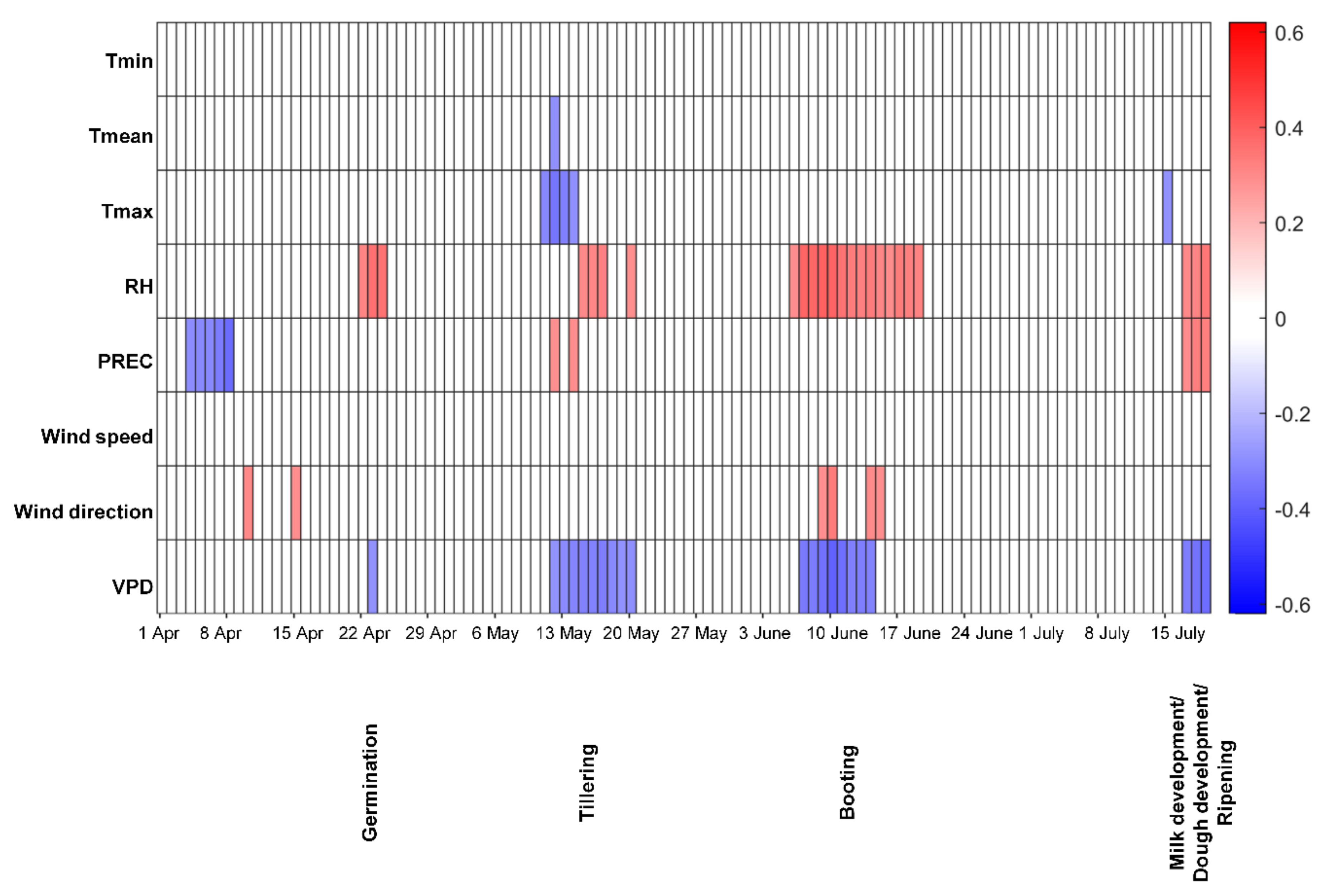

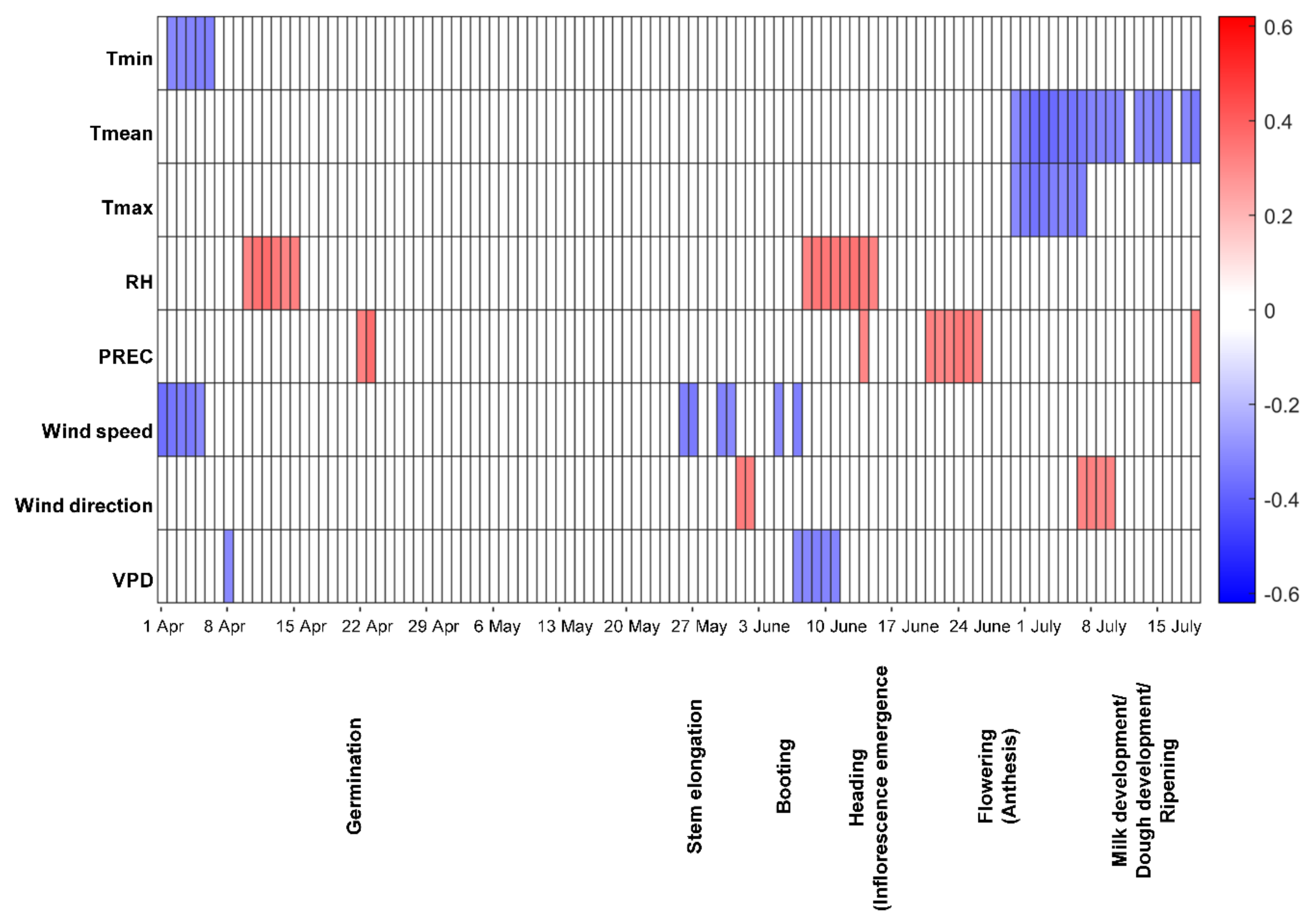
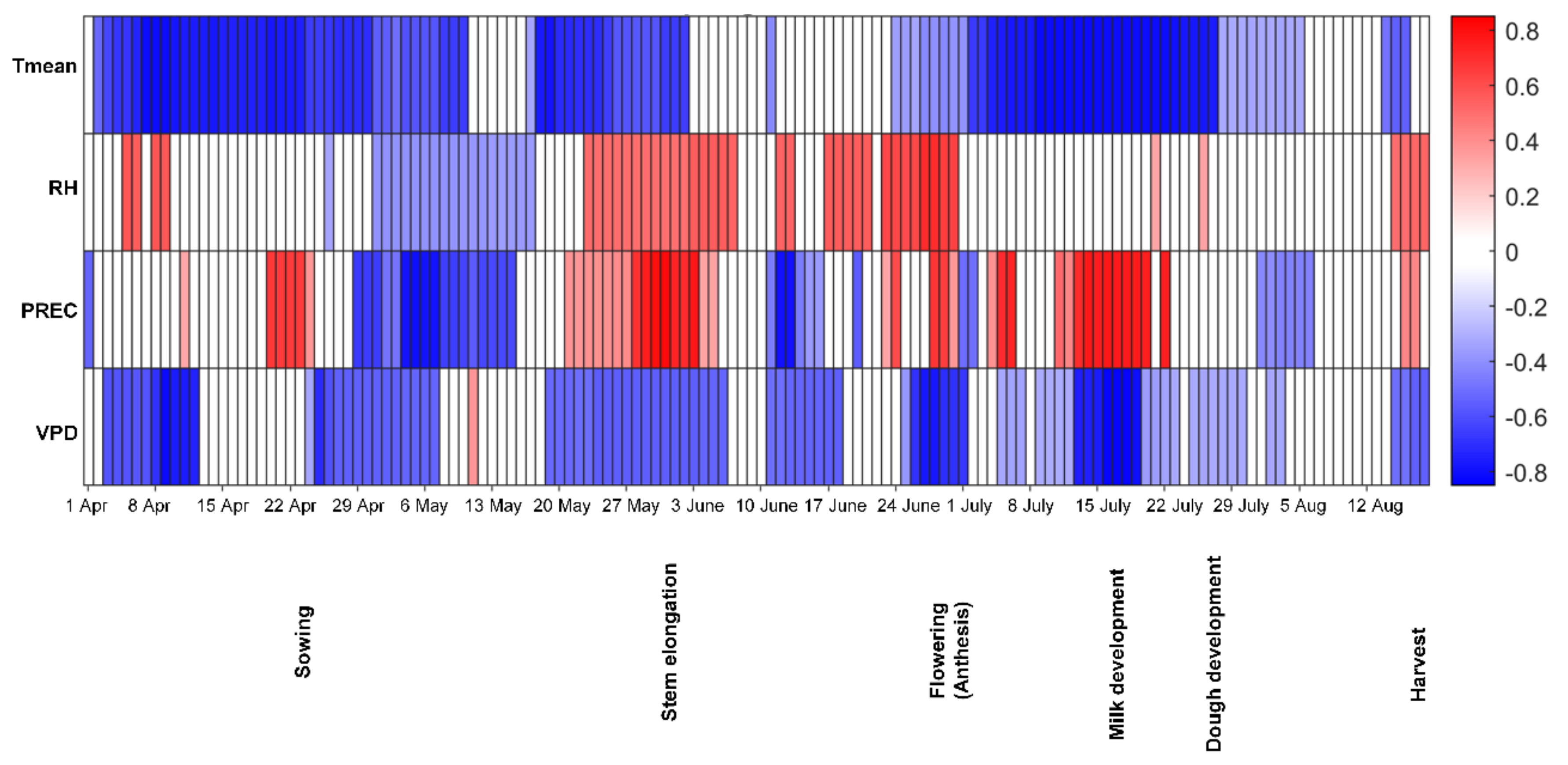


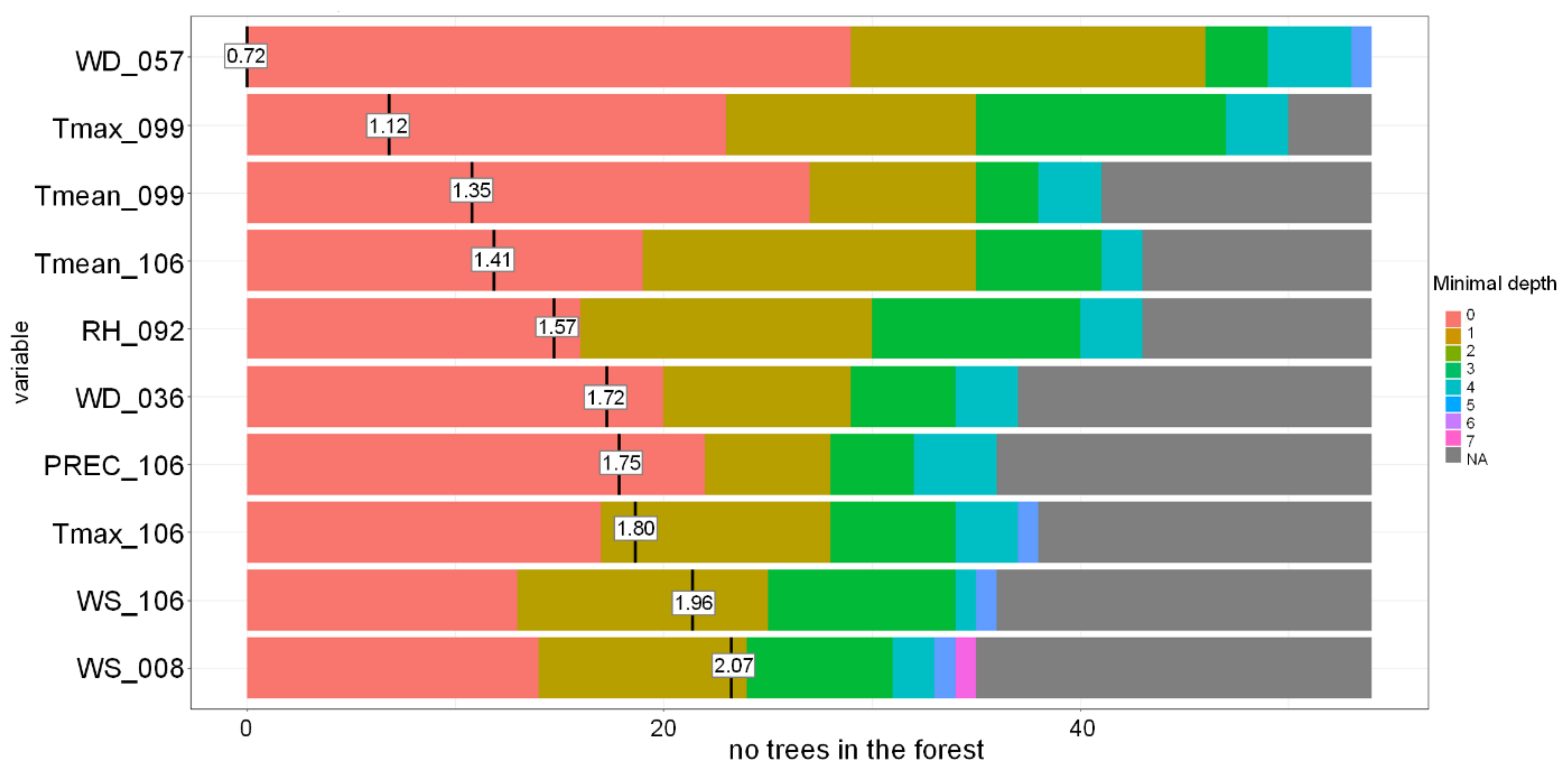

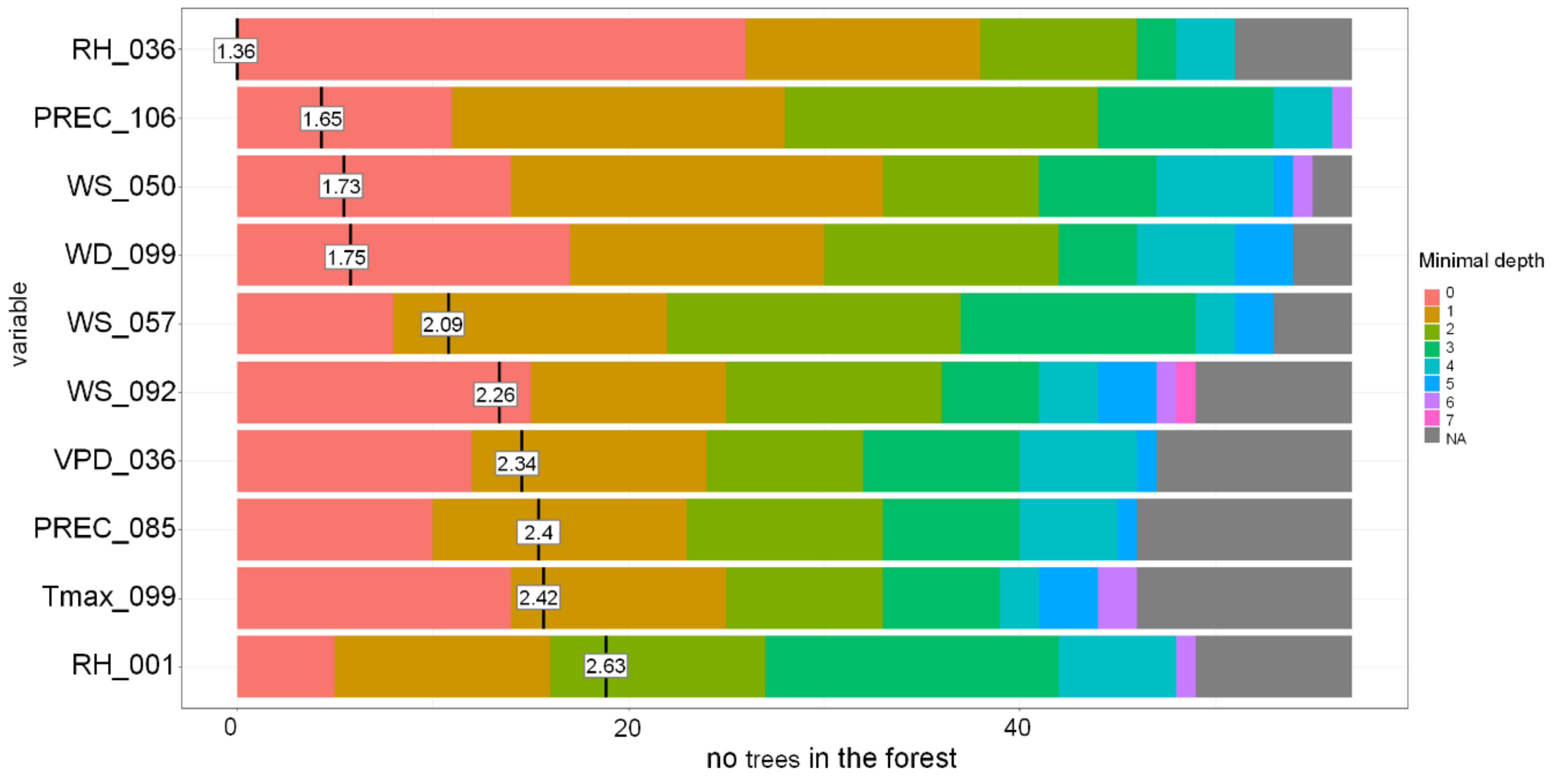

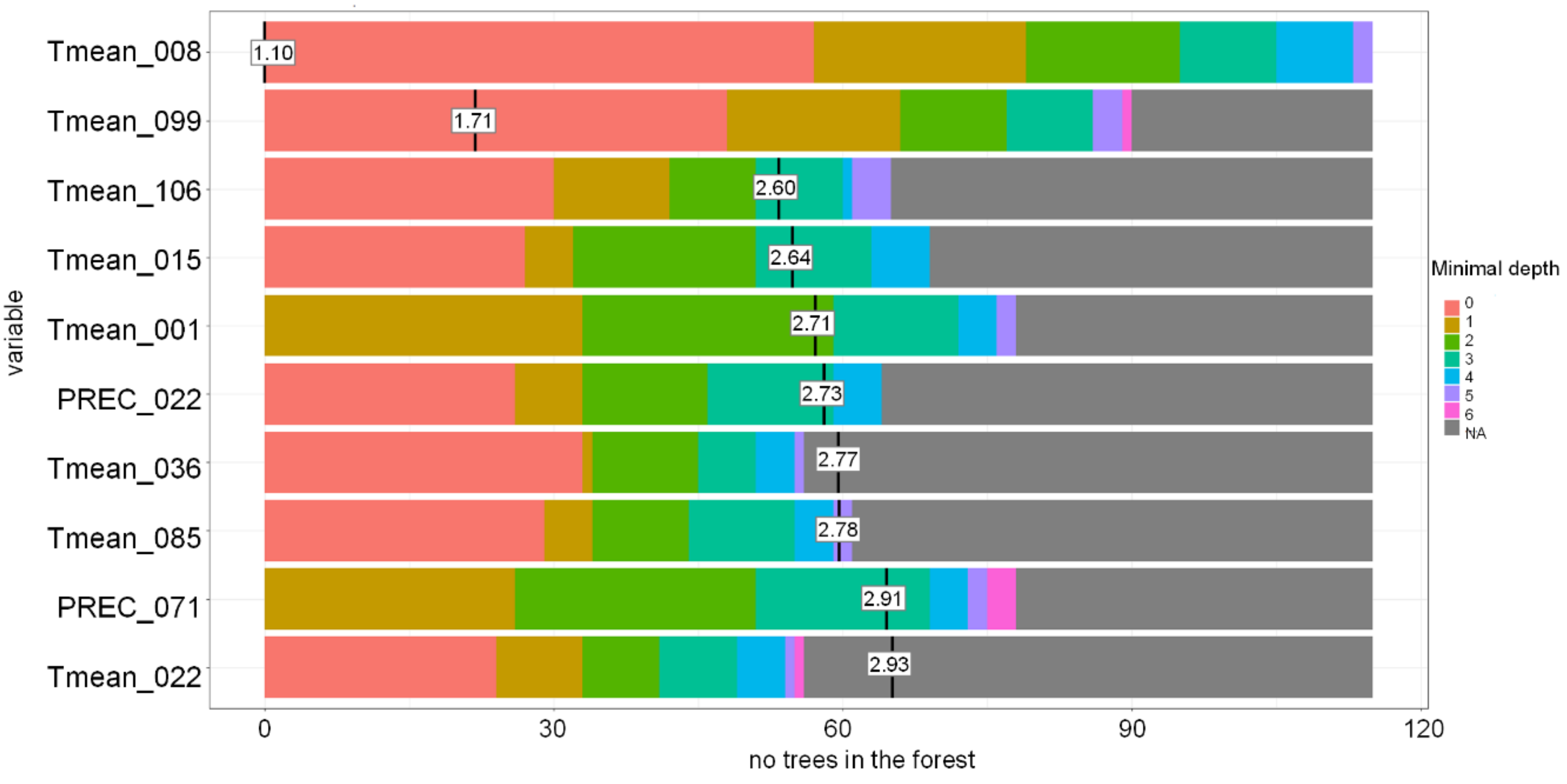


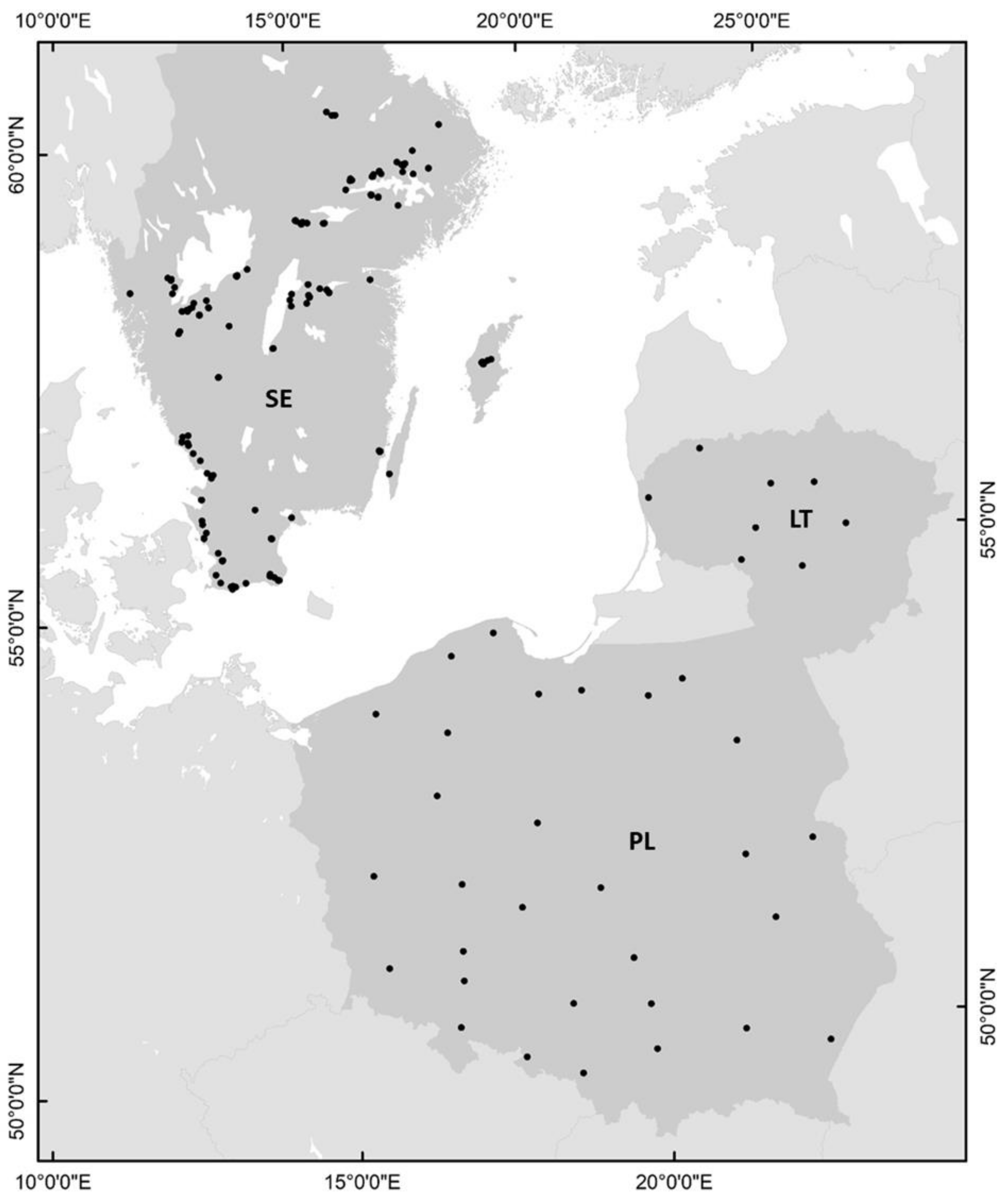
| Model | Accuracy (%) | Sensitivity 1 (%) | Specificity 2 (%) |
|---|---|---|---|
| Decision Tree | 68 | 71 | 67 |
| Random Forest | 66 | 41 | 80 |
| Support Vector Machine Linear | 70 | 75 | 67 |
| Support Vector Machine Radial | 65 | 50 | 73 |
| Model | Accuracy (%) | Sensitivity 1 (%) | Specificity 2 (%) |
|---|---|---|---|
| Decision Tree | 60 | 80 | 50 |
| Random Forest | 77 | 63 | 85 |
| Support Vector Machine Linear | 40 | 60 | 30 |
| Support Vector Machine Radial | 73 | 80 | 70 |
| Model | Accuracy (%) | Sensitivity 1 (%) | Specificity 2 (%) |
|---|---|---|---|
| Decision Tree | 65 | 33 | 100 |
| Random Forest | 60 | 58 | 62 |
| Support Vector Machine Linear | 60 | 60 | 60 |
| Support Vector Machine Radial | 80 | 90 | 70 |
| Model | Accuracy (%) | Sensitivity 1 (%) | Specificity 2 (%) |
|---|---|---|---|
| Decision Tree | 95 | 100 | 93 |
| Random Forest | 84 | 74 | 88 |
| Support Vector Machine Linear | 90 | 83 | 93 |
| Support Vector Machine Radial | 90 | 83 | 93 |
| Model | Accuracy (%) | Sensitivity 1 (%) | Specificity 2 (%) |
|---|---|---|---|
| Decision Tree | 75 | 59 | 83 |
| Random Forest | 71 | 62 | 77 |
| Support Vector Machine Linear | 69 | 81 | 63 |
| Support Vector Machine Radial | 70 | 81 | 65 |
| Species | Sweden | Poland | Lithuania | |||
|---|---|---|---|---|---|---|
| All | DON > 200 µg kg−1 Grains | All | DON > 200 µg kg−1 Grains | All | DON > 1250 µg kg−1 Grains | |
| Oats | 80 | 29 | ||||
| Spring barley | 53 | 19 | ||||
| Spring wheat | 70 | 36 | 90 | 27 | ||
| Winter wheat | 317 | 108 | ||||
| Country | Species | Zadoks Growth Scale | Date (dd.mm–dd.mm) | Data Frame |
|---|---|---|---|---|
| Sweden | oats | Germination GS0 | 27.04–30.05 | DF_022-DF_050 |
| Seedling growth GS1 | 05.05–25.05 | DF_029-DF_050 | ||
| Tillering GS2 | 11.05–12.06 | DF_036-DF_064 | ||
| Stem elongation GS3 | 27.05–29.06 | DF_057-DF_078 | ||
| Booting GS4 | 10.06–05.07 | DF_071-DF_085 | ||
| Heading (Inflorescence emergence) GS5 | 20.06–13.07 | DF_078-DF_092 | ||
| Flowering/Polination (Anthesis) GS6 | 27.06–15.07 | DF_085-DF_099 | ||
| Milk development GS7 | 04.07–22.07 | DF_092-DF_099 | ||
| Dough development GS8 | 08.07–23.07 | DF_092-DF_106 | ||
| Ripening GS9 | 12.07–27.07 | DF_092-DF_106 | ||
| spring wheat, spring barley | Germination GS0 | 20.04–17.05 | DF_015-DF_036 | |
| Seedling growth GS1 | 27.04–10.06 | DF_022-DF_057 | ||
| Tillering GS2 | 10.05–18.06 | DF_036-DF_071 | ||
| Stem elongation GS3 | 21.05–01.07 | DF_043-DF_085 | ||
| Booting GS4 | 04.06–10.07 | DF_057-DF_092 | ||
| Heading (Inflorescence emergence) GS5 | 11.06–17.07 | DF_064-DF_099 | ||
| Flowering/Polination (Anthesis) GS6 | 11.06–23.07 | DF_078-DF_106 | ||
| Milk development GS7 | 18.06–22.07 | DF_078-DF_106 | ||
| Dough development GS8 | 29.06–27.07 | DF_085-DF_106 | ||
| Ripening GS9 | 02.07–27.07 | DF_092-DF_106 | ||
| Lithuania | spring wheat | Flowering, anthesis: Full flowering, 50% of anthers mature GS65 | 10.06–14.07 | DF_071-DF_092 |
| Milk development GS7 | 01.07–28.07 | DF_092-DF_106 | ||
| Dough development GS8 | 08.07–23.07 | DF_099-DF_106 | ||
| Poland | winter wheat | Tillering GS2/Stem elongation GS3 | 01.05–14.05 | DF_001 |
| Heading GS5/Flowering GS6 (beginning) | 15.05–04.06 | DF_015-DF_022 | ||
| Flowering GS6/Milk development GS7/Dough development GS8 | 05.06–25.06 | DF_036-DF_043 | ||
| Dough development GS8/Ripening GS9 | 19.06–16.07 | DF_050-DF_064 | ||
| Harvest | 31.07–21.08 | DF_092-DF_099 |
Publisher’s Note: MDPI stays neutral with regard to jurisdictional claims in published maps and institutional affiliations. |
© 2021 by the authors. Licensee MDPI, Basel, Switzerland. This article is an open access article distributed under the terms and conditions of the Creative Commons Attribution (CC BY) license (https://creativecommons.org/licenses/by/4.0/).
Share and Cite
Marzec-Schmidt, K.; Börjesson, T.; Suproniene, S.; Jędryczka, M.; Janavičienė, S.; Góral, T.; Karlsson, I.; Kochiieru, Y.; Ochodzki, P.; Mankevičienė, A.; et al. Modelling the Effects of Weather Conditions on Cereal Grain Contamination with Deoxynivalenol in the Baltic Sea Region. Toxins 2021, 13, 737. https://doi.org/10.3390/toxins13110737
Marzec-Schmidt K, Börjesson T, Suproniene S, Jędryczka M, Janavičienė S, Góral T, Karlsson I, Kochiieru Y, Ochodzki P, Mankevičienė A, et al. Modelling the Effects of Weather Conditions on Cereal Grain Contamination with Deoxynivalenol in the Baltic Sea Region. Toxins. 2021; 13(11):737. https://doi.org/10.3390/toxins13110737
Chicago/Turabian StyleMarzec-Schmidt, Katarzyna, Thomas Börjesson, Skaidre Suproniene, Małgorzata Jędryczka, Sigita Janavičienė, Tomasz Góral, Ida Karlsson, Yuliia Kochiieru, Piotr Ochodzki, Audronė Mankevičienė, and et al. 2021. "Modelling the Effects of Weather Conditions on Cereal Grain Contamination with Deoxynivalenol in the Baltic Sea Region" Toxins 13, no. 11: 737. https://doi.org/10.3390/toxins13110737
APA StyleMarzec-Schmidt, K., Börjesson, T., Suproniene, S., Jędryczka, M., Janavičienė, S., Góral, T., Karlsson, I., Kochiieru, Y., Ochodzki, P., Mankevičienė, A., & Piikki, K. (2021). Modelling the Effects of Weather Conditions on Cereal Grain Contamination with Deoxynivalenol in the Baltic Sea Region. Toxins, 13(11), 737. https://doi.org/10.3390/toxins13110737








